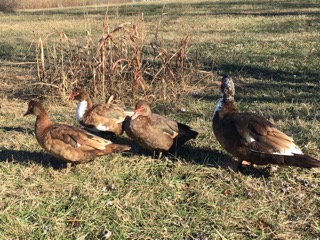 We live in an area that is rife with predators, and have shared stories of losses to owls, foxes, and hawks. We’ve had close calls with loose dogs, too. This is what seems to be the most challenging time of year for protecting our free ranging poultry, so we have to stay on our toes.
We live in an area that is rife with predators, and have shared stories of losses to owls, foxes, and hawks. We’ve had close calls with loose dogs, too. This is what seems to be the most challenging time of year for protecting our free ranging poultry, so we have to stay on our toes.
Since our property is largely rolling topography, we can only see part of it from indoors (plus an outbuilding partially obscures the view). We keep a couple of sets of binoculars handy to scan the trees for aerial predators, and make a mad dash outside as soon as a hawk is spotted. There have also been strange dogs on our property from time to time; our house dogs alert to the presence of the interlopers and nearly go through the window. Just opening a door has been enough to send the dogs running away.
We suffered heavy losses to our layers during this time last year, so we’re on high alert, especially with the loss of a duck a couple of months ago and a young pullet a month afterward. Usually, our presence is enough to scare the hopeful predators away – yesterday, as we went out to do some late morning tasks, a hawk flew out of a tree nearby, where it could have been watching the chickens and ducks. It flew to a neighboring property and wasn’t seen again that day. Today, heading out for other farm projects, we saw the Muscovies (very curious creatures) staring down at a gully on the other side of the fence. As we got closer, what looked like a stray cat – the day is gray and dreary, so the light is low – ran out from the gully and up toward the neighbor’s pasture. As we got closer, it became clear that it wasn’t a cat – it was a pair of red foxes, chicken and duck predators extraordinaire! The silly ducks were just staring at them, and didn’t move away even after the foxes had emerged from the bushes. Not perhaps the best survival strategy, but at least we were there to scare the foxes away…for now.
These experiences have shown us that we can look for certain behaviors to tip us off to the presence of a predator: if, for example, the ducks are just standing in a group and staring off in the distance, something is there. It may be a wild turkey, a group of deer, a barn cat, or a fox, but if they’re fixated on it, something is most likely there. In addition, if the chickens have disappeared (and it’s not due to cold or wet weather), they’re hiding somewhere…and very possibly from a predator. When we’re outside and we hear one of the roosters sound the alarm, a guttural “growl” of sorts, he has seen something causing concern – likely a hawk. In fairness, the roosters sometimes sound the alarm when flocks of starlings or gaggles of geese fly over, too, but we pay attention when we hear that alarm. Both ducks and chickens have better eyesight than humans do, so if we see a duck cock its head toward the sky, we look, too, because something will be there.
Predator pressure has historically eased as we approach spring, so we hope the pattern holds true again this year. Until then, we’ll be guarding the flock: scanning the hills, trees, and skies, and watching the chickens and ducks’ behavior for the telltale signs that something is amiss. Despite what they may think, “free range” does not mean “free meal” for predators!
